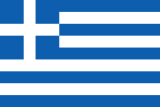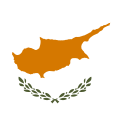 | |
| Use | National flag and ensign |
|---|---|
| Proportion | 2:3 |
| Adopted | 16 August 1960; 64 years ago (1960-08-16) (original design) 24 April 2006; 18 years ago (2006-04-24) (current version) |
| Design | An outline of the island of Cyprus in copper above two green olive branches on a white field |
| Designed by | İsmet Güney |
The flag of Cyprus (Greek: Σημαία της Κύπρου, romanized: Simaía tis Kýprou; Turkish: Kıbrıs bayrağı) came into use on 16 August 1960, under the Zürich and London Agreements, whereby a constitution was drafted and Cyprus was proclaimed an independent state. The flag was designed by Turkish Cypriot artist İsmet Güney. The design of the flag deliberately employs peaceful and neutral symbols in an attempt to indicate harmony between the Greek and Turkish Cypriot communities, an ideal that has not yet been realised. In 1963, Greek Cypriot and Turkish Cypriot communities separated because of Cypriot intercommunal violence.
The national flag features the shape of the entirety of the island, with two olive branches below (a symbol of peace between the island's two communities) on white (another symbol of peace). The olive branches signify peace between the Greek and Turkish Cypriots. The map on the flag is a copper-orange colour, symbolising the large deposits of copper ore on the island, from which it may have received its name.
Creation

The flag of the Republic of Cyprus was preceded by the flag of British Cyprus. Upon independence, Cyprus adopted a new flag. Under the constitution, the flag should "have a neutral design and colour," i.e. it should not include either blue or red colours (the colours of the flag of Greece and the flag of Turkey), nor portray a cross or a crescent.
The original proposal, made by the former British colonial administration, featured a rust-brown K on a white field. It was rejected by the President Makarios III and Vice-president Fazil Küçük, who preferred a flag proposed by İsmet Güney, a Turkish Cypriot artist.
In the design of August 1960, the colour of the map is copper (Pantone 144-C). Both the crest and the two olive-tree leaves are olive green (Pantone 336-C). The background is white with the 3:5 ratio. In April 2006 the design was updated, the shape of the olive branches were slightly altered, its color was changed to Pantone 574, the copper color of the map was changed to Pantone 1385 and the ratio was changed to 3:2.
Flags produced on Cyprus often differ from the original specifications, both regarding the size of the map and the colours used. The government announced in October 2005, that it would take steps to "start from scratch" and assure that only flags complying with the official specifications would be produced.
Under the constitution of Cyprus, the flag of Cyprus may be flown by state institutions, public corporations, and citizens of the country.
Use of the flags of Greece and Turkey

 Greek flag (left), Turkish flag (right)
Greek flag (left), Turkish flag (right)
According to the constitution, the community authorities and their institutions have the right to hoist the Greek flag or the Turkish flag alongside the flag of Cyprus during the holidays. Any citizen may, without any restriction, fly the Greek or Turkish flag, or both, next to the flag of Cyprus. Other provisions also allow municipalities, educational institutions and the National Guard to do so as well. Since the de facto division of the island, consecutive to the 1974 invasion, the flag of Greece is the only of the two flown in the area under the jurisdiction of the Republic of Cyprus, due to the predominant presence of Greek-Cypriots in that part of the island. Similarly, the flag of Turkey is only observed in the area under the control of the Turkish Republic of Northern Cyprus (recognised only by Turkey).
Colours
| This section does not cite any sources. Please help improve this section by adding citations to reliable sources. Unsourced material may be challenged and removed. (October 2024) (Learn how and when to remove this message) |
| Colour scheme | Orange | Olive green | White | |||
|---|---|---|---|---|---|---|
| RGB | 213-120-0 | 78-91-49 | 255-255-255 | |||
| CMYK | 0-44-100-16 | 14-0-46-64 | 0-0-0-0 | |||
| Web colors | D57800 | 4E5B31 | FFFFFF | |||
Proposed national flag

 One of the proposed flags of the United Republic of Cyprus
One of the proposed flags of the United Republic of Cyprus
 The British colonial administration's rejected proposal for the flag of independent Cyprus (1959).
The British colonial administration's rejected proposal for the flag of independent Cyprus (1959).Under the terms of the Annan Plan for Cyprus, a United Nations proposal to settle the Cyprus dispute, a new national flag would have been adopted by a reconstituted confederal republic of Cyprus. A competition was announced and the UN collected over 1000 proposals until 17 February 2003. Some of the proposals can be found on the webpage "Cyprus seeks new flag" by the BBC. It is possible that any future Cyprus settlement will include the adoption of a new flag.
In a referendum, the plan was accepted by Turkish Cypriots, but rejected by Greek Cypriots, therefore the plan was not put into place.
Gallery
| This section does not cite any sources. Please help improve this section by adding citations to reliable sources. Unsourced material may be challenged and removed. (October 2024) (Learn how and when to remove this message) |
-

 Flag of the Kingdom of Cyprus (15th century)
Flag of the Kingdom of Cyprus (15th century)
-

 First flag of Cyprus under British colonial rule (1881–1922)
First flag of Cyprus under British colonial rule (1881–1922)
-

 Last flag of Cyprus under British colonial rule (1922–1960)
Last flag of Cyprus under British colonial rule (1922–1960)
-

 Version of the flag used in 1960.
Version of the flag used in 1960.
-

 Version of the flag used from 16 August 1960 to 24 April 2006.
Version of the flag used from 16 August 1960 to 24 April 2006.
-

 Version of the flag used since 24 April 2006.
Version of the flag used since 24 April 2006.
-
 Presidential standard of Cyprus
Presidential standard of Cyprus
See also
References
- ^ Evripidou, Stefanos (25 June 2009). "Cyprus flag designer dies". Cyprus Mail. Archived from the original on 26 June 2009. Retrieved 11 July 2009.
- "The Flag of Cyprus". flagdb.com. Retrieved 2024-05-15.
- "Presidency of the Republic of Cyprus - The Flag". www.presidency.gov.cy. Archived from the original on 26 January 2017. Retrieved 29 November 2017.
- cahoon, ben. "Cyprus". www.worldstatesmen.org. Retrieved 29 November 2017.
- "Archived copy". Archived from the original on 2007-09-30. Retrieved 2005-10-23.
{{cite web}}: CS1 maint: archived copy as title (link) - "The Constitution of the Republic of Cyprus" (PDF).
2. The authorities of the Republic and any public corporation or public utility body created by or under the laws of the Republic shall fly the flag of the Republic and they shall have the right to fly on holidays together with the flag of the Republic both the Greek and the Turkish flags at the same time.
3. The Communal authorities and institutions shall have the right to fly on holidays together with the flag of the Republic either the Greek or the Turkish flag at the same time.
4. Any citizen of the Republic or any body, corporate or unincorporate other than public, whose members are citizens of the Republic, shall have the right to fly on their premises the flag of the Republic or the Greek or the Turkish flag without any restriction.
External links
- Flags in Cyprus
- Cyprus Flag and Emblem Archived 2012-05-29 at archive.today - Cyprus Government Web Portal
| Flags of Europe | ||
|---|---|---|
| Sovereign states |
|  |
| States with limited recognition | ||
| Dependencies and other entities | ||
| Other entities | ||
| Flags of Asia | |
|---|---|
| Sovereign states |
|
| States with limited recognition | |
| Dependencies and other territories | |
| National flags and coats of arms | |
|---|---|
| National flags | |
| National coats of arms | |
| National, regional and city flags incorporating the Union Jack | |||||||||||
|---|---|---|---|---|---|---|---|---|---|---|---|
| Sovereign states | |||||||||||
| Dependent territories |
| ||||||||||
| States, provinces and other administrative divisions |
| ||||||||||
| Cities |
| ||||||||||
| Miscellaneous |
| ||||||||||
| Historical |
| ||||||||||
